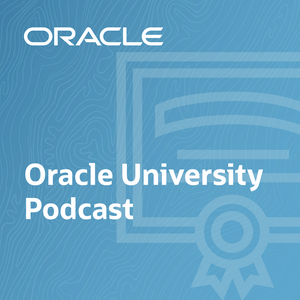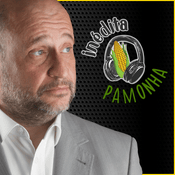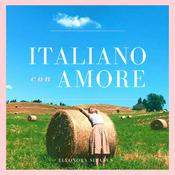148 episódios

Getting to Know Oracle Cloud Infrastructure
06/1/2026 | 19min
Every system depends on reliable infrastructure behind the scenes. Oracle Cloud Infrastructure (OCI) delivers that reliability with speed, flexibility, and built-in security. Join Lois Houston and Nikita Abraham as they speak with Oracle Cloud experts David Mills and Tijo Thomas about what makes OCI different and how it drives real results for businesses of every size. Cloud Business Jumpstart https://mylearn.oracle.com/ou/course/cloud-business-jumpstart/152957 Oracle University Learning Community: https://education.oracle.com/ou-community LinkedIn: https://www.linkedin.com/showcase/oracle-university/ X: https://x.com/Oracle_Edu Special thanks to Arijit Ghosh, David Wright, Kris-Ann Nansen, Radhika Banka, and the OU Studio Team for helping us create this episode. ----------------------------------------------- Episode Transcript: 00:00 Welcome to the Oracle University Podcast, the first stop on your cloud journey. During this series of informative podcasts, we'll bring you foundational training on the most popular Oracle technologies. Let's get started! 00:26 Lois: Hello and welcome to the Oracle University Podcast! I'm Lois Houston, Director of Communications and Adoption with Customer Success Services, and with me is Nikita Abraham, Team Lead: Editorial Services with Oracle University. Nikita: Hi everyone, and welcome to a brand-new season of the podcast! We're really excited about this one because we'll be diving into how Oracle Cloud Infrastructure is transforming the way businesses innovate, stay secure, and drive results. 00:55 Lois: And to help us with this, we've got two experts who know this space inside out—David Mills, Senior Principal PaaS Instructor, and Tijo Thomas, Principal OCI Instructor, both from Oracle University. Hi David! For those who might not be familiar, could you explain what Oracle Cloud Infrastructure is? David: OCI, as we call it, is Oracle's enterprise grade cloud platform, built from the ground up to run the systems that matter most to business. It provides the infrastructure and platform services businesses need to build, run, and scale applications securely, globally, and cost effectively. To provide more context, all of Oracle's SaaS applications such as NetSuite, Customer Experience, Human Capital Management, Supply Chain Management, as well as Enterprise Resource and Enterprise Performance Management, they all run on OCI. But OCI isn't just for Oracle's own apps. It's a full featured cloud platform used by thousands of customers to run their own applications, data, and services. OCI includes platform services such as databases, integration, analytics, and many others, and of course, the infrastructure services, such as compute, networking, and storage, which comprise the core of OCI. Bottom line, if something is running on Oracle Cloud, OCI is behind it. OCI includes over 100 services across numerous categories like compute, storage, networking, database, containers, AI, developer tools, integration, security, observability, and much more. So, whether you're lifting and shifting legacy workloads or building new apps in the cloud, OCI has the building blocks. 03:02 Lois: David, who was OCI designed for? David: OCI was built from scratch to address the limitations of first-generation clouds. No patchwork of legacy acquisitions, just a clean, modern, high-performance foundation designed for real enterprise workloads. OCI was designed for businesses that can't compromise financial services, health care, retail, governments, customers with strict regulations, global scale, and mission-critical systems. These are the companies choosing OCI not just because it works, but because it works under pressure. 03:42 Nikita: What else makes OCI different from other cloud platforms? David: Oracle's network and storage architecture delivers low latency results consistently. Then there's pricing—simple, predictable, and often much lower than our competitors. OCI was designed with governance and security in every layer. OCI supports all types of cloud strategies: public cloud, hybrid deployments, multi-cloud environments, and even a dedicated cloud we can install inside your own data center. We call all that distributed cloud, and that's where OCI really shines. OCI gives you everything you need to modernize your technology stack, run securely at scale, and build for the future without giving up control or blowing your budget. 04:37 Lois: Now, Tijo, we've covered what OCI is, who it's for, and what makes it unique. Let's switch gears a bit and talk about cloud regions. For anyone who doesn't know, a cloud region is just a specific geographic location where Oracle, or any cloud provider, runs its own data centers. Why does the choice of region matter for businesses, and what should they think about when picking one? Tijo: Many businesses are required by law to keep their data within national borders, whether it is GDPR in Europe or local privacy laws in Australia or Singapore, choosing the right region would help you to stay compliant. The closer your applications are to your users, the faster they perform. Running in a nearby region means lower latency, faster response times, and better customer experience. Then there is disaster recovery and high availability. Regions are the building blocks for setting up failover strategies. By deploying workloads in multiple regions, businesses can protect themselves from outages and keeping their systems in running state. Some businesses also need to meet industry-specific compliance requirements. Think of sectors like health care, government, or finance. They often require that the infrastructure and the data should stay within the national or regional boundaries. If your business is growing into new markets, regions allow you to deploy apps and services closer to your customers and without having the need to build new data centers. Regions also enable local integrations and partnerships, whether it is connecting with ISPs, local service providers, or complying with in-country partner requirements. Having a region nearby makes that integrations and operations smoother. Regions are not just about geography. They are a critical part of how the businesses would stay compliant, resilient, and responsive across the globe. Oracle runs a fast-growing global network of cloud regions, and each OCI region is fully independent and fully isolated. You choose your regions, and your data stays there. 07:06 Nikita: And are there different types of cloud regions? Tijo: There are several commercial regions, sovereign regions, government regions, and multi-cloud regions. Even with a wide range of cloud regions, some organizations cannot move their workloads and its data to the public cloud. Those workloads may need to stay in their own on-premises data center, but at the same time, they still want to leverage the benefits of OCI. 07:42 Take your cloud skills to the next level with the new Oracle Database@AWS course. Master provisioning, migration, security, and high availability for Oracle Database on AWS. Then validate your experience with an industry-recognized certification. Stand out in the multicloud space and accelerate your career. Visit mylearn.oracle.com for more information. 08:09 Nikita: Welcome back! We were talking about workloads and how some companies may have to keep their workloads on-premises. Why would they need to do that, Tijo? Tijo: First, data sovereignty. Let's say there may not be a list of public cloud region that the organization is looking for, or maybe the business need to set up a disaster recovery strategy within that specific location. Then there is security and control. Some industries have very strict regulations, and they require physical access and oversight of their infrastructure. And finally, there are latency-sensitive workloads. These are applications that cannot afford the delay of going back and forth to a remote cloud region. They need cloud services right next to their physical data center. 08:59 Nikita: So, how does Oracle help with that? Tijo: To address these requirements, Oracle introduces a set of offerings. The first one is called dedicated region, and the second one is called Cloud@Customer services. Through both these offerings, you get OCI services right in your data center and all behind your firewall, while achieving the benefits of flexibility and automation. 09:24 Nikita: So, what's a dedicated region? Tijo: Dedicated region is a completely managed cloud region that brings all the OCI services and Oracle Fusion SaaS applications within your data centers. Along with deploying the full stack OCI, you would receive support for Oracle Fusion SaaS applications and also gain a consistent experience with the same SLAs, APIs, and the tools available in Oracle Cloud. 09:53 Lois: Ok and what about Cloud@Customer? Tijo: While dedicated region is ideal for large scale enterprise needs, with full stack OCI and SaaS, some organizations just require a lighter footprint. And that's where Cloud@Customer comes in. And to begin with, we'll talk about Compute Cloud@Customer. It is a fully managed rack scale infrastructure that allows you to use the core OCI services, like the OCI compute, OCI storage, and OCI networking services at your on-premises. With Compute Cloud@Customer, you can run applications and middleware systems to provide consistent user experience and simplify IT administration across your distributed cloud architecture. We can plan to run the same application stack everywhere and centrally manage them without needing experts in every location. 10:52 Nikita: Is there a way to make running your Oracle databases easier and more cost-effective? Tijo: That's why Oracle offers you Oracle Exadata Cloud@Customer. Oracle Exadata Cloud@Customer combines the performance of Oracle Exadata with the simplicity, flexibility, and affordability of a managed database service delivered through customer data centers. It is the simplest way to move your current Oracle databases to the cloud, because it provides full compatibility with existing Exadata systems and Exadata Database services in Oracle Cloud Infrastructure. You could also run the fully-managed Oracle Autonomous Database on Exadata Cloud@Customer that would combine all the benefits of having Exadata, along with the simplicity of an autonomous cloud service. And when Compute Cloud@Customer is combined with Exadata Cloud@Customer, you can run full stack applications completely in your own data center. Applications will use the same high performance OCI compute and database services you get in the cloud, so you don't have to change the way you architect or deploy them. 12:09 Nikita: So, what you're saying is that Oracle dedicated region and Cloud@Customer bring OCI services into your data center. Tijo: It enables you to run applications faster using the same high-performance capabilities and autonomous operations. You get all of this while maintaining complete control of your data so that you can address data residency, security, and connectivity concerns. 12:35 Lois: Ok. We've talked about where OCI runs. Now David, let's get into what it actually does. David: OCI compute lets you run business applications on demand without buying or managing physical servers. You choose the type and size of the virtual machine you want, and OCI handles the rest. Need more power for peak traffic? OCI can automatically add capacity and scale it back down after. In addition to virtual machines, bare metal servers are also available for ultra high performance jobs like simulations, AI, or high speed trading. Every business stores data, but not all data needs the same kind of storage. OCI gives you options, fast block storage for your compute servers. It works just like a hard drive for your home computer. Shared file storage for applications and microservices. Large scale object storage for backups, videos, or other data, and low-cost long-term storage for object archives. The system even moves rarely used data to cheaper storage automatically. 13:51 Lois: Given Oracle's expertise in databases, what are some of the database options businesses can access with OCI? David: Oracle Autonomous Database automatically patches, tunes, and scales itself. Need raw power? Use Oracle Exadata, or go open source with MySQL HeatWave, which can be used for real time analytics. With these and many other database options, you get high performance automation and reliability all on demand. 14:24 Nikita: With so many database options, how is everything kept connected and running smoothly on OCI? David: Every cloud service relies on a fast, secure network. OCI's Virtual Cloud network acts like your own private data highway. You control how traffic flows between your apps, your people, and your regions. Need private direct connections to your data center or office? Use OCI FastConnect to bypass the public internet. OCI networking provides high speed performance with enterprise grade security designed for global business. 15:05 Lois: And what security service does Oracle provide? David: OCI doesn't treat this as an optional add on. When you sign up for OCI, your environment is isolated, your data is encrypted, and admin actions are logged. And there are so many security services. Identity and Access Management for handling users and permissions, Cloud Guard to detect threats and misconfigurations, OCI Vault for managing your encryption keys, Data Safe to monitor sensitive data access, as well as many others. You can leverage to meet any government or business compliance requirement. All of these are included in OCI, no need to stitch together third-party tools. 15:55 Lois: What if I want to see what's going on in my environment? David: OCI has monitoring services for metrics, logging services for real-time insights, tracing for distributed applications, and alarms to notify you when things go sideways. All of these services are integrated. So you can see what matters when you need it without all the noise. 16:23 Nikita: David, let's say someone wants to build and deploy an app. What services does OCI offer them? David: OCI provides numerous developer services for your teams to build apps or digital tools. OCI DevOps supports automated builds and deployments. OCI Container Engine for Kubernetes helps run microservices. OCI Functions supports serverless code that runs on demand. All of this works with familiar languages and frameworks. In short, OCI gives developers what they need to build, test, and deliver quickly without having to manage infrastructure. 17:03 Nikita: How does OCI make it easier for companies to bring their apps together and use AI, even if they don't have a dedicated AI team? David: Modern businesses run dozens of apps, and OCI helps you to connect them with Oracle Integration Cloud. With OIC, you can integrate SaaS applications as well as on-premise apps and systems, automate business processes and workflows, route and transform messages, and you can even expose key services as APIs so partners and systems can interact securely. OCI integration is the glue that holds modern IT together. OCI helps you turn data into decisions without needing an AI team. Use ready-made AI tools for language translation, image recognition, document understanding, speech transcription, and more. Or build your own models with data science and data flow services. It's all designed to bring machine learning into reach for every business. 18:10 Lois: Thank you, David and Tijo, for joining us on this episode of the Oracle University Podcast. If you want to learn more about OCI, visit mylearn.oracle.com and search for the Cloud Business Jumpstart course. Nikita: Next week, we'll look at why businesses choose OCI and how they're using OCI services to create real outcomes. Until then, this is Nikita Abraham… Lois: And Lois Houston signing off! 18:38 That's all for this episode of the Oracle University Podcast. If you enjoyed listening, please click Subscribe to get all the latest episodes. We'd also love it if you would take a moment to rate and review us on your podcast app. See you again on the next episode of the Oracle University Podcast.

Best of 2025: Unlocking the Power of Oracle APEX and AI
23/12/2025 | 15min
Lois Houston and Nikita Abraham explore how Oracle APEX integrates with AI to build smarter low-code applications. They are joined by Chaitanya Koratamaddi, Director of Product Management at Oracle, who explains the basics of Oracle APEX, its global adoption, and the challenges it addresses for businesses managing and integrating data. They also explore real-world use cases of AI within the Oracle APEX ecosystem Oracle APEX: Empowering Low Code Apps with AI: https://mylearn.oracle.com/ou/course/oracle-apex-empowering-low-code-apps-with-ai/146047/ Oracle University Learning Community: https://education.oracle.com/ou-community LinkedIn: https://www.linkedin.com/showcase/oracle-university/ X: https://x.com/Oracle_Edu Special thanks to Arijit Ghosh, David Wright, Kris-Ann Nansen, Radhika Banka, and the OU Studio Team for helping us create this episode. --------------------------------------------------- Episode Transcript: 00:00 Welcome to the Oracle University Podcast, the first stop on your cloud journey. During this series of informative podcasts, we'll bring you foundational training on the most popular Oracle technologies. Let's get started! 00:25 Lois: Hello and welcome to the Oracle University Podcast! I'm Lois Houston, Director of Communications and Adoption with Customer Success Services, and with me is Nikita Abraham, Team Lead: Editorial Services with Oracle University. Nikita: Hi everyone! We hope you've been enjoying these last few weeks as we've been revisiting our most popular episodes of the year. Today's episode is the last one in this series and is a throwback to a conversation on APEX with Chaitanya Koratamaddi, Director of Product Management for Oracle APEX. 00:57 Lois: We began by asking Chaitanya what Oracle APEX is and why it's so widely used. So, let's jump right in! Chaitanya: Oracle APEX is the world's most popular enterprise low code application platform. APEX enables you to build secure and scalable enterprise-scale applications with world class features that can be deployed anywhere, cloud or on-premises. And with APEX, you can build applications 20 times faster with 100 times less code. APEX delivers the most productive way to develop and deploy mobile and web applications everywhere. 01:40 Lois: That's impressive. So, what's the adoption rate like for Oracle APEX? Chaitanya: As of today, there are 19 million plus APEX applications created globally. 5,000 plus APEX applications are created on a daily basis and there are 800,000 plus APEX developers worldwide. 60,000 plus customers in 150 countries across various industry verticals. And 75% of Fortune 500 companies use Oracle APEX. 02:19 Nikita: Wow, the numbers really speak for themselves, right? But Chaitanya, why are organizations adopting Oracle APEX at this scale? Or to put it differently, what's the core business challenge that Oracle APEX is addressing? Chaitanya: From databases to all data, you know that the world is more connected and automated than ever. To drive new business value, organizations need to explore and exploit new sources of data that are generated from this connected world. That can be sounds, feeds, sensors, videos, images, and more. Businesses need to be able to work with all types of data and also make sure that it is available to be used together. Typically, businesses need to work on all data at a massive scale. For example, supply chains are no longer dependent just on inventory, demand, and order management signals. A manufacturer should be able to understand data describing global weather patterns and how it impacts their supply chains. Businesses need to pull in data from as many social sources as possible to understand how customer sentiment impacts product sales and corporate brands. Our customers need a data platform that ensures all this data works together seamlessly and easily. 04:00 Lois: So, you're saying Oracle APEX is the platform that helps businesses manage and integrate data seamlessly. But data is just one part of the equation, right? Then there's AI. How are the two related? Chaitanya: Before we start talking about Oracle AI, let's first talk about what customers are looking for and where they are struggling within their AI innovation. It all starts with data. For decades, working with data has largely involved dealing with structured data, whether it is your customer records in your CRM application and orders from your ERP database. Data was organized into database and tables, and when you needed to find some insights in your data, all you need to do is just use stored procedures and SQL queries to deliver the answers. But today, the expectations are higher. You want to use AI to construct sophisticated predictions, find anomalies, make decisions, and even take actions autonomously. And the data is far more complicated. It is in an endless variety of formats scattered all over your business. You need tools to find this data, consume it, and easily make sense of it all. And now capabilities like natural language processing, computer vision, and anomaly detection are becoming very essential just like how SQL queries used to be. You need to use AI to analyze phone call transcripts, support tickets, or email complaints so you can understand what customers need and how they feel about your products, customer service, and brand. You may want to use a data source as noisy and unstructured as social media data to detect trends and identify issues in real time. Today, AI capabilities are very essential to accelerate innovation, assess what's happening in your business, and most importantly, exceed the expectations of your customers. So, connecting your application, data, and infrastructure allows everyone in your business to benefit from data. 06:54 Oracle University is proud to announce three brand new courses that will help your teams unlock the power of Redwood—the next generation design system. Redwood enhances the user experience, boosts efficiency, and ensures consistency across Oracle Fusion Cloud Applications. Whether you're a functional lead, configuration consultant, administrator, developer, or IT support analyst, these courses will introduce you to the Redwood philosophy and its business impact. They'll also teach you how to use Visual Builder Studio to personalize and extend your Fusion environment. Get started today by visiting mylearn.oracle.com. 07:35 Nikita: Welcome back! So, let's focus on AI across the Oracle Cloud ecosystem. How does Oracle bring AI into the mix to connect applications, data, and infrastructure for businesses? Chaitanya: By embedding AI throughout the entire technology stack from the infrastructure that businesses run on through the applications for every line of business, from finance to supply chain and HR, Oracle is helping organizations pragmatically use AI to improve performance while saving time, energy, and resources. Our core cloud infrastructure includes a unique AI infrastructure layer based on our supercluster technology, leveraging the latest and greatest hardware and uniquely able to get the maximum out of the AI infrastructure technology for scenarios such as large language processing. Then there is generative AI and ML for data platforms. On top of the AI infrastructure, our database layer embeds AI in our products such as autonomous database. With autonomous database, you can leverage large language models to use natural language queries rather than writing a SQL when interacting with the autonomous database. This enables you to achieve faster AI adoption in your application development. Businesses and their customers can use the Select AI natural language interface combined with Oracle Database AI Vector Search to obtain quicker, more intuitive insights into their own data. Then we have AI services. AI services are a collection of offerings, including generative AI with pre-built machine learning models that make it easier for developers to apply AI to applications and business operations. The models can be custom-trained for more accurate business results. 09:47 Nikita: And what specific AI services do we have at Oracle, Chaitanya? Chaitanya: We have Oracle Digital Assistant Speech, Language, Vision, and Document Understanding. Then we have Oracle AI for Applications. Oracle delivers AI built for business, helping you make better decisions faster and empowering your workforce to work more effectively. By embedding classic and generative AI into its applications, Fusion Apps customers can instantly access AI outcomes wherever they are needed without leaving the software environment they use every day to power their business. 10:32 Lois: Let's talk specifically about APEX. How does APEX use the Gen AI and machine learning models in the stack to empower developers. How does it help them boost productivity? Chaitanya: Starting APEX 24.1, you can choose your preferred large language models and leverage native generative AI capabilities of APEX for AI assistants, prompt-based application creation, and more. Using native OCI capabilities, you can leverage native platform capabilities from OCI, like AI infrastructure and object storage, etc. Oracle APEX running on autonomous infrastructure in Oracle Cloud leverages its unique native generative AI capabilities tuned specifically on your data. These language models are schema aware, data aware, and take into account the shape of information, enabling your applications to take advantage of large language models pre-trained on your unique data. You can give your users greater insights by leveraging native capabilities, including vector-based similarity search, content summary, and predictions. You can also incorporate powerful AI features to deliver personalized experiences and recommendations, process natural language prompts, and more by integrating directly with a suite of OCI AI services. 12:08 Nikita: Can you give us some examples of this? Chaitanya: You can leverage OCI Vision to interpret visual and text inputs, including image recognition and classification. Or you can use OCI Speech to transcribe and understand spoken language, making both image and audio content accessible and actionable. You can work with disparate data sources like JSON, spatial, graphs, vectors, and build AI capabilities around your own business data. So, low-code application development with APEX along with AI is a very powerful combination. 12:51 Nikita: What are some use cases of AI-powered Oracle APEX applications? Chaitanya: You can build APEX applications to include conversational chatbots. Your APEX applications can include image and object detection capability. Your APEX applications can include speech transcription capability. And in your applications, you can include code generation that is natural language to SQL conversion capability. Your applications can be powered by semantic search capability. Your APEX applications can include text generation capability. 13:30 Lois: So, there's really a lot we can do! Thank you, Chaitanya, for joining us today. With that, we're wrapping up this episode. We covered Oracle APEX, the key challenges businesses face when it comes to AI innovation, and how APEX and AI work together to give businesses an AI edge. Nikita: Yeah, and if you want to know more about Oracle APEX, visit mylearn.oracle.com and search for the Oracle APEX: Empowering Low Code Apps with AI course. Lois: We hope you've enjoyed revisiting some of our most popular episodes of the year. We always appreciate your feedback and suggestions so do write to us at [email protected]. That's [email protected]. We're taking a break next week and will be back with a brand-new season of the Oracle University Podcast in January. Happy holidays, everybody! Nikita: Happy holidays! Until next time, this is Nikita Abraham... Lois: And Lois Houston, signing off! 14:34 That's all for this episode of the Oracle University Podcast. If you enjoyed listening, please click Subscribe to get all the latest episodes. We'd also love it if you would take a moment to rate and review us on your podcast app. See you again on the next episode of the Oracle University Podcast.

Best of 2025: Oracle Fusion Cloud Applications Foundations Training & Certifications
16/12/2025 | 11min
In this episode of the Oracle University Podcast, hosts Lois Houston and Nikita Abraham dive into Oracle Fusion Cloud Applications and the new courses and certifications on offer. They are joined by Oracle Fusion Apps experts Patrick McBride and Bill Lawson who introduce the concept of Oracle Modern Best Practice (OMBP), explaining how it helps organizations maximize results by mapping Fusion Application features to daily business processes. They also discuss how the new courses educate learners on OMBP and its role in improving Fusion Cloud Apps implementations. OMBP: https://www.oracle.com/applications/modern-best-practice/ Oracle University Learning Community: https://education.oracle.com/ou-community LinkedIn: https://www.linkedin.com/showcase/oracle-university/ X: https://x.com/Oracle_Edu Special thanks to Arijit Ghosh, David Wright, Kris-Ann Nansen, Radhika Banka, and the OU Studio Team for helping us create this episode. ----------------------------------------------------- Episode Transcript: 00:00 Welcome to the Oracle University Podcast, the first stop on your cloud journey. During this series of informative podcasts, we'll bring you foundational training on the most popular Oracle technologies. Let's get started! 00:25 Nikita: Hello and welcome to the Oracle University Podcast! I'm Nikita Abraham, Team Lead of Editorial Services with Oracle University, and with me is Lois Houston, Director of Communications and Adoption with Customer Success Services. Lois: Hi everyone! Thanks for joining us for this Best of 2025 series, where we're playing you four of our most popular episodes of the year. Nikita: Today's episode is #3 of 4 and is a throwback to a conversation with our friends and Oracle Fusion Apps experts Patrick McBride and Bill Lawson. We chatted with them about the latest courses and certifications available for Oracle Fusion Cloud Applications, featuring Oracle Modern Best Practice and the Oracle Cloud Success Navigator. 01:08 Lois: We kicked things off by asking Patrick to help us understand what Oracle Modern Best Practice is, and the reasons behind its creation. Patrick: So, modern best practices are more than just a business process. They're really about translating features and technology into actionable capabilities in our product. So, we've created these by curating industry leading best practices we've collected from our customers over the years. And ensure that the most modern technologies that we've built into the Fusion Application stack are represented inside of those business processes. Our goal is really to help you as customers improve your business operations by easily finding and applying those technologies to what you do every day. 01:53 Nikita: So, by understanding this modern best practice and the technology that enables it, you're really unlocking the full potential of Fusion Apps. Patrick: Absolutely. So, the goal is that modern best practice make it really easy for customers, implementers, partners, to see the opportunity and take action. 02:13 Lois: That's great. OK, so, let's talk about implementations, Patrick. How do Oracle Modern Best Practice support customers throughout the lifecycle of an Oracle Fusion Cloud implementation? Patrick: What we found during many implementers' journey with taking our solution and trying to apply it with customers is that customers come in with a long list of capabilities that they're asking us to replicate. What they've always done in the past. And what modern best practice is trying to do is help customers to reimage the art of the possible…what's possible with Fusion by taking advantage of innovative features like AI, like IoT, like, you know, all of the other solutions that we built in to help you automate your processes to help you get the most out of the solution using the latest and greatest technology. So, if you're an implementer, there's a number of ways a modern best practice can help during an implementation. First is that reimagine exercise where you can help the customer see what's possible. And how we can do it in a better way. I think more importantly though, as you go through your implementation, many customers aren't able to get everything done by the time they have to go live. They have a list of things they've deferred and modern best practices really establishes itself as a road map for success, so you can go back to it at the completion and see what's left for the opportunity to take advantage of and you can use it to track kind of the continuous innovation that Oracle delivers with every release and see what's changed with that business process and how can I get the most out of it. 03:43 Nikita: Thanks, Patrick. That's a great primer on OMBP that I'm sure everyone will find very helpful. Patrick: Thanks, Niki. We want our customers to understand the value of modern best practices so they can really maximize their investment in Oracle technology today and in the future as we continue to innovate. 03:59 Lois: Right. And the way we're doing that is through new training and certifications that are closely aligned with OMBP. Bill, what can you tell us about this? Bill: Yes, sure. So, the new Oracle Fusion Applications Foundations training program is designed to help partners and customers understand Oracle Modern Best Practice and how they improve the entire implementation journey with Fusion Cloud Applications. As a learner, you will understand how to adhere to these practices and how they promise a greater level of success and customer satisfaction. So, whether you're designing, or implementing, or going live, you'll be able to get it right on day one. So, like Patrick was saying, these OMBPs are reimagined, industry-standard business processes built into Fusion Applications. So, you'll also discover how technologies like AI, Mobile, and Analytics help you automate tasks and make smarter decisions. You'll see how data flows between processes and get tips for successful go-lives. So, the training we're offering includes product demonstrations, key metrics, and design considerations to give you a solid understanding of modern best practice. It also introduces you to Oracle Cloud Success Navigator and how it can be leveraged and relied upon as a trusted source to guide you through every step of your cloud journey, so from planning, designing, and implementation, to user acceptance testing and post-go-live innovations with each quarterly new release of Fusion Applications and those new features. And then, the training also prepares you for Oracle Cloud Applications Foundations certifications. 05:31 Nikita: Which applications does the training focus on, Bill? Bill: Sure, so the training focuses on four key pillars of Fusion Apps and the associated OMBP with them. For Human Capital Management, we cover Human Resources and Talent Management. For Enterprise Resource Planning, it's all about Financials, Project Management, and Risk Management. In Supply Chain Management, you'll look at Supply Chain, Manufacturing, Inventory, Procurement, and more. And for Customer Experience, we'll focus on Marketing, Sales, and Service. 05:59 Lois: That's great, Bill. Now, who is the training and certification for? Bill: That's a great question. So, it's really for anyone who wants to get the most out of Oracle Fusion Cloud Applications. It doesn't matter if you're an experienced professional or someone new to Fusion Apps, this is a great place to start. It's even recommended for professionals with experience in implementing other applications, like on-premise products. So, the goal is to give you a solid foundation in Oracle Modern Best Practice and show you how to use them to improve your implementation approach. We want to make it easy for anyone, whether you're an implementer, a global process owner, or an IT team employee, to identify every way Fusion Applications can improve your organization. So, if you're new to Fusion Apps, you'll get a comprehensive overview of Oracle Fusion Applications and how to use OMBP to improve business operations. If you're already certified in Oracle Cloud Applications and have years of experience, you'll still benefit from learning how OMBP fits into your work. If you're an experienced Fusion consultant who is new to Oracle Modern Best Practice processes, this is a good place to begin and learn how to apply them and the latest technology enablers during implementations. And, lastly, if you're an on-premise or you have non-Fusion consultant skills looking to upskill to Fusion, this is a great way to begin acquiring the knowledge and skills needed to transition to Fusion and migrate your existing expertise. 07:29 Have you mastered the basics of AI? Are you ready to take your skills to the next level? Unlock the potential of advanced AI with our OCI Generative AI Professional course and certification that covers topics like Large Language Models, the OCI Generative AI Service, and building Q&A chatbots for real-world applications. Head over to mylearn.oracle.com and find out more. 07:58 Nikita: Welcome back! Bill, how long is it going to take me to complete this training program? Bill: So, we wanted to make this program detailed enough so our learners find it valuable, obviously. But at the same time, we didn't want to make it too long. So, each course is approximately 5 hours or more, and provides folks with all the requisite knowledge they need to get started with Oracle Modern Best Practice and Fusion Applications. 08:22 Lois: Bill, is there anything that I need to know before I take this course? Are there any prerequisites? Bill: No, Lois, there are no prerequisites. Like I was saying, whether you're fresh out of college or a seasoned professional, this is a great place to start your journey into Fusion Apps and Oracle Modern Best Practice. 08:37 Nikita: That's great, you know, that there are no barriers to starting. Now, Bill, what can you tell us about the certification that goes along with this new program? Bill: The best part, Niki, is that it's free. In fact, the training is also free. We have four courses and corresponding Foundation Associate–level certifications for Human Capital Management, Enterprise Resource Planning, Supply Chain Management, and Customer Experience. So, completing the training prepares you for an hour-long exam with 25 questions. It's a pretty straightforward way to validate your expertise in Oracle Modern Best Practice and Fusion Apps implementation considerations. 09:11 Nikita: Ok. Say I take this course and certification. What can I do next? Where should my learning journey take me? Bill: So, you're building knowledge and expertise with Fusion Applications, correct? So, once you take this training and certification, I recommend that you identify a product area you want to specialize in. So, if you take the Foundations training for HCM, you can dive deeper into specialized paths focused on implementing Human Resources, Workforce Management, Talent Management, or Payroll applications, for example. The same goes for other product areas. If you finish the certification for Foundations in ERP, you may choose to specialize in Finance or Project Management and get your professional certifications there as your next step. So, once you have this foundational knowledge, moving on to advanced learning in these areas becomes much easier. We offer various learning paths with associated professional-level certifications to deepen your knowledge and expertise in Oracle Fusion Cloud Applications. So, you can learn more about these courses by visiting oracle.com/education/training/ to find out more of what Oracle University has to offer. 10:14 Lois: Right. I love that we have a clear path from foundational-level training to more advanced levels. So, as your skills grow, we've got the resources to help you move forward. Nikita: That's right, Lois. Thanks for walking us through all this, Patrick and Bill. We really appreciate you taking the time to join us on the podcast. Bill: Yeah, it's always a pleasure to join you on the podcast. Thank you very much. Patrick: Oh, thanks for having me, Lois. Happy to be here. Nikita: We hope you enjoyed that conversation. Join us next week for another throwback episode. Until then, this is Nikita Abraham... Lois: And Lois Houston, signing off! 10:47 That's all for this episode of the Oracle University Podcast. If you enjoyed listening, please click Subscribe to get all the latest episodes. We'd also love it if you would take a moment to rate and review us on your podcast app. See you again on the next episode of the Oracle University Podcast.

Best of 2025: What is Multicloud?
09/12/2025 | 11min
This week, hosts Lois Houston and Nikita Abraham are shining a light on multicloud, a game-changing strategy involving the use of multiple cloud service providers. Joined by Senior Manager of CSS OU Cloud Delivery Samvit Mishra, they discuss why multicloud is becoming essential for businesses, offering freedom from vendor lock-in and the ability to cherry-pick the best services. They also talk about Oracle's pioneering role in multicloud and its partnerships with Microsoft Azure, Google Cloud, and Amazon Web Services. Oracle Cloud Infrastructure Multicloud Architect Professional: https://mylearn.oracle.com/ou/course/oracle-cloud-infrastructure-multicloud-architect-professional-2025-/144474 Oracle University Learning Community: https://education.oracle.com/ou-community LinkedIn: https://www.linkedin.com/showcase/oracle-university/ X: https://x.com/Oracle_Edu Special thanks to Arijit Ghosh, David Wright, Kris-Ann Nansen, and the OU Studio Team for helping us create this episode. ------------------------------------------------------ Episode Transcript: 00:00 Welcome to the Oracle University Podcast, the first stop on your cloud journey. During this series of informative podcasts, we'll bring you foundational training on the most popular Oracle technologies. Let's get started! 00:25 Lois: Welcome to the Oracle University Podcast! I'm Lois Houston, Director of Communications and Adoption with Customer Success Services, and with me is Nikita Abraham, Team Lead: Editorial Services with Oracle University. Nikita: Hi everyone! You're listening to our Best of 2025 series, where over the next few weeks, we're revisiting four of our most popular episodes of the year. Lois: Today is #2 of 4, and we're throwing it back to an episode with Senior Manager of CSS OU Cloud Delivery Samvit Mishra. This episode was all about shining a light on multicloud, a game-changing strategy involving the use of multiple cloud service providers. 01:07 Nikita: That's right, Lois. Oracle has been an early adopter of multicloud and a pioneer in multicloud services. So, we began that conversation by asking Samvit to explain what multicloud is and why someone would need more than one cloud provider. Samvit: Multicloud is a very simple, basic concept. It is the coordinated use of cloud services from more than one cloud service provider. 01:30 Nikita: But why would someone want to use more than one cloud service provider? Samvit: There are many reasons why a customer might want to leverage two or more cloud service providers. First, it addresses the very real concern of mitigating or avoiding vendor lock-in. By using multiple providers, companies can avoid being tied down to one vendor and maintain their flexibility. 01:53 Lois: That's like not putting all your eggs in one basket, so to speak. Samvit: Exactly. Another reason is that customers want the best of breed. What that means is basically leveraging or utilizing the best product from one cloud service provider and pairing it against the best product from another cloud service provider. Getting a solution out of the combined products…out of the coordinated use of those services. 02:22 Nikita: So, it sounds like multicloud is becoming the new normal. And as we were saying before, Oracle was a pioneer in this space. But why did we embrace multicloud so wholeheartedly? Samvit: We recognized that our customers were already moving in this direction. Independent studies from Flexera found that 89% of the subjects of the study used multicloud. And we conducted our own study and came to similar numbers. Over 90% of our customers use two or more cloud service providers. HashiCorp, the big infrastructure as code company, came to similar numbers as well, 94%. They basically asked companies if multicloud helped them advance their business goals. And 94% said yes. And all this is very recent data. 03:13 Lois: Can you give us the backstory of Oracle's entry into the multicloud space? Samvit: Sure. So back in 2019, Oracle and Microsoft Azure joined forces and announced the interconnect service between Oracle Cloud Infrastructure and Microsoft Azure. The interconnect was between Oracle's FastConnect and Microsoft Azure's ExpressRoute. This was a big step, as it allowed for a direct connection between the two providers without needing a third-party. And now we have several of our data centers interconnected already. So, out of the 48 regions, 12 of them are already interconnected. And more are coming. And you can very easily configure the interconnect. This interconnectivity guarantees low latency, high throughput, and predictable performance. And also, on the OCI side, there are no egress or ingress charges for your data. There's also a product called Oracle Database@Azure, where Oracle and Microsoft deliver Oracle Database services in Microsoft Azure data centers. 04:20 Lois: That's exciting! And what are the benefits of this product? Samvit: The main advantage is the co-location. Being co-located with the Microsoft Azure data center offers you native integration between Azure and OCI resources. No manual configuration of a private interconnect between the two providers is needed. You're going to get microsecond latency between your applications and the Oracle Database. The OCI-native Exadata Database Service is available on Oracle Database@Azure. This enables you to get the highest level of Oracle Database performance, scalability, security, and availability. And your tech support can be provided either from Microsoft or from Oracle. 05:11 AI is being used in nearly every industry…healthcare, manufacturing, retail, customer service, transportation, agriculture, you name it! And it's only going to get more prevalent and transformational in the future. It's no wonder that AI skills are the most sought-after by employers. If you're ready to dive in to AI, check out the OCI AI Foundations training and certification that's available for free! It's the perfect starting point to build your AI knowledge. So, get going! Head on over to mylearn.oracle.com to find out more. 05:51 Nikita: Welcome back. Samvit, there have been some new multicloud milestones from OCI, right? Can you tell us about them? Samvit: That's right, Niki. I am thrilled to share the latest news on Oracle's multicloud partnerships. We now have agreements with Microsoft Azure, Google Cloud, and Amazon Web Services. So, as we were discussing earlier, with Azure, we have the Oracle Interconnect for Azure and Oracle Database@Azure. Now, with Google Cloud, we have the Oracle Interconnect for Google Cloud. And it is very similar to the Oracle Interconnect for Azure. With Google Cloud, we have physically interconnected data centers and they provide a sub-2 millisecond latency private interconnection. So, you can come in and provision virtual circuits going from Oracle FastConnect to Google Cloud Interconnect. And the best thing is that there are no egress or ingress charges for your data. The way it is structured is you have your Oracle Cloud Infrastructure on one side, with your virtual cloud network, your subnets, and your resources. And on the other side, you have your Google Cloud router with your virtual private cloud subnet and your resources interconnecting. You initiate the connectivity on the Google Cloud side, retrieve the service key and provide that service key to Oracle Cloud Infrastructure, and complete the interconnection on the OCI side. So, for example, our US East Ashburn interconnect will match with us-east4 on the Google Cloud side. 07:29 Lois: Now, wasn't the other major announcement Oracle Database@Google Cloud? Tell us more about that, please. Samvit: With Oracle Database@Google Cloud, you can run your applications on Google Cloud and the database inside the Google Cloud platform. That's the Oracle Cloud Infrastructure database co-located in Google Cloud platform data centers. It allows you to run native integration between GCP and OCI resources with no manual configuration of private interconnect between these two cloud service providers. That means no FastConnect, no Interconnect because, again, the database is located in the Google Cloud data center. And you're going to get microsecond latency and the OCI native Exadata Database Service. So, you're going to gain the highest level of Oracle Database performance, scalability, security, and availability. 08:25 Lois: And how is the tech support managed? Samvit: The technical support is a collaboration between Google Cloud and Oracle Cloud Infrastructure. That means you can either have the technical support provided to completion by Google Cloud or by Oracle. One of us will provide you with an end-to-end solution. 08:43 Nikita: During CloudWorld last year, we also announced Oracle Database@AWS, right? Samvit: Yes, Niki. That's where Oracle and Amazon Web Services deliver the Oracle Database service on Oracle Cloud Infrastructure in your AWS data center. This will provide you with native integration between AWS and OCI resources, with no manual configuration of private interconnect between AWS and OCI. And you're getting microsecond latency with the OCI-native Exadata Database Service. And again, as with Oracle Database@Google Cloud and Oracle Database@Azure, you're gaining the highest level of Oracle Database performance, scalability, security, and availability. And the technical support is provided by either AWS or Oracle all the way to completion. Now, Oracle Database@AWS is currently available in limited preview, with broader availability in the coming months as it expands to new regions to meet the needs of our customers. 09:49 Lois: That's great. Now, how does Oracle fare when it comes to pricing, especially compared to our major cloud competitors? Samvit: Our pricing is pretty consistent. You'll see that in all cases across the world, we have the less expensive solution for you and the highest performance as well. 10:06 Nikita: Let's move on to some use cases, Samvit. How might a company use the multicloud setup? Samvit: Let's start with the split-stack architecture between Oracle Cloud Infrastructure and Microsoft Azure. Like I was saying earlier, this partnership dates back to 2019. And basically, we eliminated the FastConnect partner from the middle. And this will provide you with high throughput, low latency, and very predictable performance, all of this on highly available links. These links are redundant, ensuring business continuity between OCI and Azure. And you can have your database on the OCI side and your application on Microsoft Azure side or the other way around. You can have SQL Server on Azure and the application running on Oracle Cloud Infrastructure. And this is very easy to configure. 10:55 Lois: It really sounds like Oracle is at the forefront of the multicloud revolution. Thanks so much, Samvit, for shedding light on this exciting topic. Samvit: It was my pleasure. Nikita: That's a wrap for today. To learn more about what we discussed, head over to mylearn.oracle.com and search for the Oracle Cloud Infrastructure Multicloud Architect Professional course. Lois: We hope you enjoyed that conversation. Join us next week for another throwback episode. Until then, this is Lois Houston... Nikita: And Nikita Abraham, signing off! 11:26 That's all for this episode of the Oracle University Podcast. If you enjoyed listening, please click Subscribe to get all the latest episodes. We'd also love it if you would take a moment to rate and review us on your podcast app. See you again on the next episode of the Oracle University Podcast.

Best of 2025: Introduction to MySQL
02/12/2025 | 26min
Join hosts Lois Houston and Nikita Abraham as they explore the world of MySQL 8.4. Together with Perside Foster, a MySQL Principal Solution Engineer, they break down the fundamentals of MySQL, its wide range of applications, and why it's so popular among developers and database administrators. This episode also covers key topics like licensing options, support services, and the various tools, features, and plugins available in MySQL Enterprise Edition. MySQL 8.4 Essentials: https://mylearn.oracle.com/ou/course/mysql-84-essentials/141332/226362 Oracle University Learning Community: https://education.oracle.com/ou-community LinkedIn: https://www.linkedin.com/showcase/oracle-university/ X: https://x.com/Oracle_Edu Special thanks to Arijit Ghosh, David Wright, Kris-Ann Nansen, Radhika Banka, and the OU Studio Team for helping us create this episode. ----------------------------------------------------- Episode Transcript: 00:00 Welcome to the Oracle University Podcast, the first stop on your cloud journey. During this series of informative podcasts, we'll bring you foundational training on the most popular Oracle technologies. Let's get started! 00:25 Nikita: Hello and welcome to the Oracle University Podcast! I'm Nikita Abraham, Team Lead of Editorial Services with Oracle University, and with me is Lois Houston, Director of Communications and Adoption with Customer Success Services. Lois: Hi there! If you've been following along with us, you'll know we've had some really interesting seasons this year. We covered MySQL, Multicloud, APEX, GoldenGate, Artificial Intelligence, and Cloud Tech. Nikita: And we've had some pretty awesome special guests too. Do go back and check out those episodes if any of these topics interest you. Lois: As we close out the year, we thought this would be a good time to revisit some of our best episodes. So over the next few weeks, you'll be able to listen to four of our most popular episodes of the year. 01:12 Nikita: Right, this is the best of the best according to you our listeners. Today's episode is #1 of 4 and is a throwback to a discussion with MySQL Principal Solution Engineer Perside Foster on the Oracle MySQL ecosystem and its various components. We began by asking Perside to explain what MySQL is and why it's so widely used. So, let's get to it! Perside: MySQL is a relational database management system that organizes data into structured tables, rows, and columns for efficient programming and data management. MySQL is transactional by nature. When storing and managing data, actions such as selecting, inserting, updating, or deleting are required. MySQL groups these actions into a transaction. The transaction is saved only if every part completes successfully. 02:13 Lois: Now, how does MySQL work under the hood? Perside: MySQL is a high-performance database that uses its default storage engine, known as InnoDB. InnoDB helps MySQL handle complex operations and large data volumes smoothly. 02:33 Nikita: For the unversed, what are some day-to-day applications of MySQL? How is it used in the real world? Perside: MySQL works well with online transaction processing workloads. It handles transactions quickly and manages large volumes of transaction at once. OLTP, with low latency and high throughput, makes MySQL ideal for high-speed environments like banking or online shopping. MySQL not only stores data but also replicates it from a main server to several replicas. 03:14 Nikita: That's impressive! And what are the benefits of using MySQL? Perside: It improves data availability and load balancing, which is crucial for businesses that need up-to-date information. MySQL replication supports read scale-out by distributing queries across servers, which increases high availability. MySQL is the most popular database on the web. 03:44 Lois: And why is that? What makes it so popular? What sets it apart from the other database management systems? Perside: First, it is a relational database management system that supports SQL. It also works as a document store, enabling the creation of both SQL and NoSQL applications without the need for separate NoSQL databases. Additionally, MySQL offers advanced security features to protect data integrity and privacy. It also uses tablespaces for better disk space management. This gives database administrators total control over their data storage. MySQL is simple, solid in its reliability, and secure by design. It is easy to use and ideal for both beginners and professionals. MySQL is proven at scale by efficiently handling large data volumes and high transaction rates. MySQL is also open source. This means anyone can download and use it for free. Users can modify the MySQL software to meet their needs. However, it is governed by the GNU General Public License, or GPL. GPL outlines specific rules for its use. MySQL offers two major editions. For developers and small teams, the Community Edition is available for free and includes all of the core features needed. For large enterprises, the Commercial Edition provides advanced features, management tools, and dedicated technical support. 05:42 Nikita: Ok. Let's shift focus to licensing. Who is it useful for? Perside: MySQL licensing is essential for independent software vendors. They're called ISVs. And original manufacturers, they're called OEMs. This is because these companies often incorporate MySQL code into their software products or hardware system to boost the functionality and performance of their product. MySQL licensing is equally important for value-added resellers. We call those VARs. And also, it's important for other distributors. These groups bundle MySQL with other commercially licensed software to sell as part of their product offering. The GPL v.2 license might suit Open Source projects that distribute their products under that license. 06:46 Lois: But what if some independent software vendors, original manufacturers, or value-add resellers don't want to create Open Source products. They don't want their source to be publicly available and they want to keep it private. What happens then? Perside: This is why Oracle provides a commercial licensing option. This license allows businesses to use MySQL in their products without having to disclose their source code as required by GPL v2. 07:17 Nikita: I want to bring up the robust support services that are available for MySQL Enterprise. What can we expect in terms of support, Perside? Perside: MySQL Enterprise Support provides direct access to the MySQL Support team. This team consists of experienced MySQL developers, who are experts in databases. They understand the issues and challenges their customers face because they, too, have personally tackled these issues and challenges. This support service operates globally and is available in 29 languages. So no matter where customers are located, Oracle Support provides assistance, most likely in their preferred language. MySQL Enterprise Support offers regular updates and hot fixes to ensure that the MySQL customer systems stays current with the latest improvements and security patches. MySQL Support is available 24 hours a day, 7 days a week. This ensures that whenever there is an issue, Oracle Support can provide the needed help without any delay. There are no restrictions on how many times customers can receive help from the team because MySQL Enterprise Support allows for unlimited incidents. MySQL Enterprise Support goes beyond simply fixing issues. It also offers guidance and advice. Whether customers require assistance with performance tuning or troubleshooting, the team is there to support them every step of the way. 09:11 Lois: Perside, can you walk us through the various tools and advanced features that are available within MySQL? Maybe we could start with MySQL Shell. Perside: MySQL Shell is an integrated client tool used for all MySQL database operations and administrative functions. It's a top choice among MySQL users for its versatility and powerful features. MySQL Shell offers multi-language support for JavaScript, Python, and SQL. These naturally scriptable languages make coding flexible and efficient. They also allow developers to use their preferred programming language for everything, from automating database tasks to writing complex queries. MySQL Shell supports both document and relational models. Whether your project needs the flexibility of NoSQL's document-oriented structures or the structured relationships of traditional SQL tables, MySQL Shell manages these different data types without any problems. Another key feature of MySQL Shell is its full access to both development and administrative APIs. This ability makes it easy to automate complex database operations and do custom development directly from MySQL Shell. MySQL Shell excels at DBA operations. It has extensive tools for database configuration, maintenance, and monitoring. These tools not only improve the efficiency of managing databases, but they also reduce the possibility for human error, making MySQL databases more reliable and easier to manage. 11:21 Nikita: What about the MySQL Server tool? I know that it is the core of the MySQL ecosystem and is available in both the community and commercial editions. But how does it enhance the MySQL experience? Perside: It connects with various devices, applications, and third-party tools to enhance its functionality. The server manages both SQL for structured data and NoSQL for schemaless applications. It has many key components. The parser, which interprets SQL commands. Optimizer, which ensures efficient query execution. And then the queue cache and buffer pools. They reduce disk usage and speed up access. InnoDB, the default storage engine, maintains data integrity and supports robust transaction and recovery mechanism. MySQL is designed for scalability and reliability. With features like replication and clustering, it distributes data, manage more users, and ensure consistent uptime. 12:44 Nikita: What role does MySQL Enterprise Edition play in MySQL server's capabilities? Perside: MySQL Enterprise Edition improves MySQL server by adding a suite of commercial extensions. These exclusive tools and services are designed for enterprise-level deployments and challenging environments. These tools and services include secure online backup. It keeps your data safe with efficient backup solutions. Real-time monitoring provides insight into database performance and health. The seamless integration connects easily with existing infrastructure, improving data flow and operations. Then you have the 24/7 expert support. It offers round the clock assistance to optimize and troubleshoot your databases. 13:48 Lois: That's an extensive list of features. Now, can you explain what MySQL Enterprise plugins are? I know they're specialized extensions that boost the capabilities of MySQL server, tools, and services, but I'd love to know a little more about how they work. Perside: Each plugin serves a specific purpose. Firewall plugin protects against SQL injection by allowing only pre-approved queries. The audit plugin logs database activities, tracking who accesses databases and what they do. Encryption plugin secures data at rest, protecting it from unauthorized access. Then we have the authentication plugin, which integrates with systems like LDAP and Active Directory for control access. Finally, the thread pool plugin optimizes performance in high load situation by effectively controlling how many execution threads are used and how long they run. The plugin and tools are included in the MySQL Enterprise Edition suite. 15:16 Join the Oracle University Learning Community and tap into a vibrant network of over 1 million members, including Oracle experts and fellow learners. This dynamic community is the perfect place to grow your skills, connect with likeminded learners, and celebrate your successes. As a MyLearn subscriber, you have access to engage with your fellow learners and participate in activities in the community. Visit community.oracle.com/ou to check things out today! 15:47 Nikita: Welcome back! We've been going through the various MySQL tools, and another important one is MySQL Enterprise Backup, right? Perside: MySQL Enterprise Backup is a powerful tool that offers online, non-blocking backup and recovery. It makes sure databases remain available and performs optimally during the backup process. It also includes advanced features, such as incremental and differential backup. Additionally, MySQL Enterprise Backup supports compression to reduce backups and encryptions to keep data secure. One of the standard capabilities of MySQL Enterprise Backup is its seamless integration with media management software, or MMS. This integration simplifies the process of managing and storing backups, ensuring that data is easily accessible and secure. Then we have the MySQL Workbench Enterprise. It enhances database development and design with robust tools for creating and managing your diagram and ensuring proper documentation. It simplifies data migration with powerful tools that makes it easy to move databases between platforms. For database administration, MySQL Workbench Enterprise offers efficient tools for monitoring, performance tuning, user management, and backup and recovery. MySQL Enterprise Monitor is another tool. It provides real-time MySQL performance and availability monitoring. It helps track database's health and performance. It visually finds and fixes problem queries. This is to make it easy to identify and address performance issues. It offers MySQL best-practice advisors to guide users in maintaining optimal performance and security. Lastly, MySQL Enterprise Monitor is proactive and it provides forecasting. 18:24 Lois: Oh that's really going to help users stay ahead of potential issues. That's fantastic! What about the Oracle Enterprise Manager Plugin for MySQL? Perside: This one offers availability and performance monitoring to make sure MySQL databases are running smoothly and efficiently. It provides configuration monitoring. This is to help keep track of the database settings and configuration. Finally, it collects all available metrics to provide comprehensive insight into the database operation. 19:03 Lois: Are there any tools designed to handle higher loads and improve security? Perside: MySQL Enterprise Thread Pool improves scalability as concurrent connections grows. It makes sure the database can handle increased loads efficiently. MySQL Enterprise Authentication is another tool. This one integrates MySQL with existing security infrastructures. It provides robust security solutions. It supports Linux PAM, LDAP, Windows, Kerberos, and even FIDO for passwordless authentication. 19:46 Nikita: Do any tools offer benefits like customized logging, data protection, database security? Perside: The MySQL Enterprise Audit provides out-of-the-box logging of connections, logins, and queries in XML or JSON format. It also offers simple to fine-grained policies for filtering and log rotation. This is to ensure comprehensive and customizable logging. MySQL Enterprise Firewall detects and blocks out of policy database transactions. This is to protect your data from unauthorized access and activities. We also have MySQL Enterprise Asymmetric Encryption. It uses MySQL encryption libraries for key management signing and verifying data. It ensures data stays secure during handling. MySQL Transparent Data Encryption, another tool, provides data-at-rest encryption within the database. The Master Key is stored outside of the database in a KMIP 1.1-compliant Key Vault. That is to improve database security. Finally, MySQL Enterprise Masking offers masking capabilities, including string masking and dictionary replacement. This ensures sensitive data is protected by obscuring it. It also provides random data generators, such as range-based, payment card, email, and social security number generators. These tools help create realistic but anonymized data for testing and development. 21:56 Lois: Can you tell us about HeatWave, the MySQL cloud service? We're going to have a whole episode dedicated to it soon, but just a quick introduction for now would be great. Perside: MySQL HeatWave offers a fully managed MySQL service. It provides deployment, backup and restore, high availability, resizing, and read replicas, all the features you need for efficient database management. This service is a powerful union of Oracle Infrastructure and MySQL Enterprise Edition 8. It combines robust performance with top-tier infrastructure. With MySQL HeatWave, your systems are always up to date with the latest security fixes, ensuring your data is always protected. Plus, it supports both OLTP and analytics/ML use cases, making it a versatile solution for diverse database needs. 23:05 Nikita: So to wrap up, what are your key takeways when it comes to MySQL? Perside: When you use MySQL, here is the bottom line. MySQL Enterprise Edition delivers unmatched performance at scale. It provides advanced monitoring and tuning capabilities to ensure efficient database operation, even under heavy loads. Plus, it provides insurance and immediate help when needed, allowing you to depend on expert support whenever an issue arises. Regarding total cost of ownership, TCO, this edition significantly reduces the risk of downtime and enhances productivity. This leads to significant cost savings and improved operational efficiency. On the matter of risk, MySQL Enterprise Edition addresses security and regulatory compliance. This is to make sure your data meets all necessary standards. Additionally, it provides direct contact with the MySQL team for expert guidance. In terms of DevOps agility, it supports automated scaling and management, as well as flexible real-time backups, making it ideal for agile development environments. Finally, concerning customer satisfaction, it enhances application performance and uptime, ensuring your customers have a reliable and smooth experience. 25:02 Lois: Thank you so much, Perside. This is really insightful information. To learn more about all the support services that are available, visit support.oracle.com. This is the central hub for all MySQL Enterprise Support resources. Nikita: Yeah, and if you want to know about the key commercial products offered by MySQL, visit mylearn.oracle.com and search for the MySQL 8.4: Essentials course. Lois: We hope you enjoyed that conversation. Join us next week for another throwback episode. Until then, this is Lois Houston… Nikita: And Nikita Abraham, signing off! 25:39 That's all for this episode of the Oracle University Podcast. If you enjoyed listening, please click Subscribe to get all the latest episodes. We'd also love it if you would take a moment to rate and review us on your podcast app. See you again on the next episode of the Oracle University Podcast.
Mais podcasts de Ensino
Podcasts em tendência em Ensino
Sobre Oracle University Podcast
Ouça Oracle University Podcast, Inglês Todos os Dias e muitos outros podcasts de todo o mundo com o aplicativo o radio.net

Obtenha o aplicativo gratuito radio.net
- Guardar rádios e podcasts favoritos
- Transmissão via Wi-Fi ou Bluetooth
- Carplay & Android Audo compatìvel
- E ainda mais funções
Obtenha o aplicativo gratuito radio.net
- Guardar rádios e podcasts favoritos
- Transmissão via Wi-Fi ou Bluetooth
- Carplay & Android Audo compatìvel
- E ainda mais funções


Oracle University Podcast
baixe o aplicativo,
ouça.





































